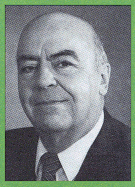Vol. 18 No. 1
January, 1988
|
Make Tomorrow Happen
|

Preserving the
Past for the
Future
|

Omer Lavallee
Railway Historian
|
As a follow-up to last month's column about the 20th
anniversary of the Natinal Museum of Science and Technology, I'd like to share a few of my own perceptions about
historical preservation of railway equipment outside the realm of the national museums.
I was first involved in the conservation movement nearly 40 years ago - in 1949 to be precise - when a few colleagues
and I formed the Cornwall Electric Railway Society to preserve a 1930s-era, Cornwall, Ontario,
streetcar, the rail passenger system in that city having been replaced by buses.
The Cornwall Street Raiway Light & Power Company, through its general manager, Donald Seymour, allowed us to
continue to have fan trips since the bulk of the electrified track mileage had to be retained for the company's
industrial switching service, which continued until the 1970s. Our group is believed to have been the first
amateur-sponsored, operating railway historical group in Canada.
FROM FEW TO MANY
Up to that time, the number of preserved railway locomotives and cars in this country could literally be counted on
the fingers of both hands. Nearly four decades later, the number of these artifacts in Canada is approaching one
thousand, of which about 150 are cabooses.
In addition, there are hundreds of car bodies used for storage buildings, summer camps, etc. They are scattered about
the countryside and can not really be considered historical objects as such.
Most of the material is static, rather than in operating form. Unfortunately, a good deal of it is also visually
unpresentable, reflecting unfavorable not only upon the custodians but also upon the former owning organizations,
as the original identification of such vehicles is usually obvious.
It is small wonder that the railways have become much more selective in recent years in making equipment available
for this purpose, much of which has little to do with history in the accepted sense.
CANADIAN TRACKSIDE GUIDE
Those of my readers who are interested in details of "preserved" equipment, such as identity and location,
should obtain a copy of Canadian Trackside Guide, published by the Bytown Railway Society, Box 141, Station A,
Ottawa, Ontario, Canada, K1N 8V1.
This 200-page publication, issued annually, also contains listings of current main line and industrial
motive power, rolling stock of urban transportation systems, and much more. The 1988 issue will be available by the
time that this appears in print and will cost about $10.
In the same vein, recently I was contacted by Carolyn Carradine, of Los Angeles, California. She and her husband own
the former CP Rail station from Asquith, Saskatchewan, which they use as a vacation home about 10 kilometres north of
its former site.
Mrs. Carradine would like to contact other people who own former railway stations to exchange information and
impressions. Her address is 2350 Sunset Plaza Drive, Los Angeles, California, USA, 90069. Perhaps our readers can
pass this request on to non-CP Rail personnel who possess such structures.
Next month, I'll talk about operating tourist railways.
This CP Rail News article is copyright
1988 by the Canadian Pacific Railway and is reprinted here with
their permission. All photographs, logos, and trademarks are the property of the Canadian Pacific Railway
Company.
|